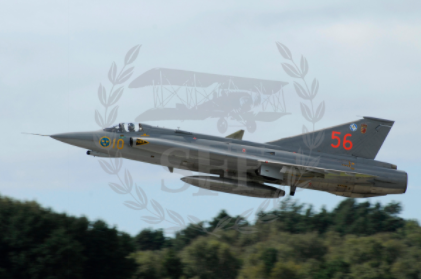J 35 The dragon
This diorama shows the J 35J Dragon standing as a “gatekeeper” at the exit to the Aeroseum.
The kite was designed to be a replacement for the day fighter J 29 Tunnan and the all-weather fighter J 32B Lansen. It would thus be able to operate both during the day and at night, and in all weathers. It was expected that an attacking enemy would fly in at high altitude at a speed around the speed of sound. To defend against this, an aircraft with a high top speed and the ability to quickly climb to high altitudes was needed.
The prototype for the Dragon first flew on 25 October 1955, and the first production aircraft was delivered to the Air Force, F13 in Norrköping, on 8 March 1960. The Dragon was then in service with the Air Force until December 1999.
The kite was produced in many versions; J 35A, B, D, F and J, SK 35C and S 35E. In addition to these, some versions were also produced for export to Finland, Denmark and Austria. Some ended up after their service in Denmark in the USA where they were privately registered. The difference between the different versions has been the engine and afterburner, armament options, amount of fuel and the electronics. The SK 35C differed from the others by being a two-seat aircraft intended to be used for new pilots to familiarize themselves with the type. The S 35E lacked armament and radar but instead had 7 cameras, 5 in the nose and one in each wing.
The engine in the Dragon was a development of the British Rolls Royce Avon. This engine was license manufactured by Svensk Flygmotor AB in Trollhättan under the name RM6. This was a further development of the same engine that had previously been in the Lansen.
A total of 615 SAAB 35s were produced. The number depends a little on how you count. For example. 26 J 35As were split in half, 26 new two-seater front fuselages were built and assembled with the J 35A rear fuselages. In this way, 26 Sk 35Cs were obtained. The aircraft that were exported were a mixture of newly manufactured and refurbished used ones from the Air Force. A total of 48 aircraft were exported to Finland, 51 to Denmark and 24 to Austria.
The accident statistics for the Draken are 147 total breakdowns with 44 dead drivers, distributed among 136 breakdowns with 40 fatalities in Sweden, 9 breakdowns with 3 fatalities in Denmark, 2 breakdowns and 1 fatality in Finland and no breakdowns in Austria. It is true that 3 times as many Dragons were flown in Sweden as in the other countries combined, but Sweden is still overrepresented in the accident statistics.

Aircraft J 35 Draken, is still flying with the SwAFHF.
Image from the Swedish Aviation History Association.
Some data about the Draken, J 35J:
Length: 15.34m
Span: 9.42 m
Engine: SFA RM 6C
Max take-off weight: 12,562 kg
Fuel volume: 2,865 liters + 4 drop tanks of 525 liters each
Maximum speed: 2,150 km/h
Peak Altitude: 20,000 m
Armament: A 30mm Akan, attack rockets, radar or IR robots, and fighter missiles.
Starting distance: 920 m with ebk, 1340 without.
Landing distance: 870 m with brake parachute, 1,240 without.
